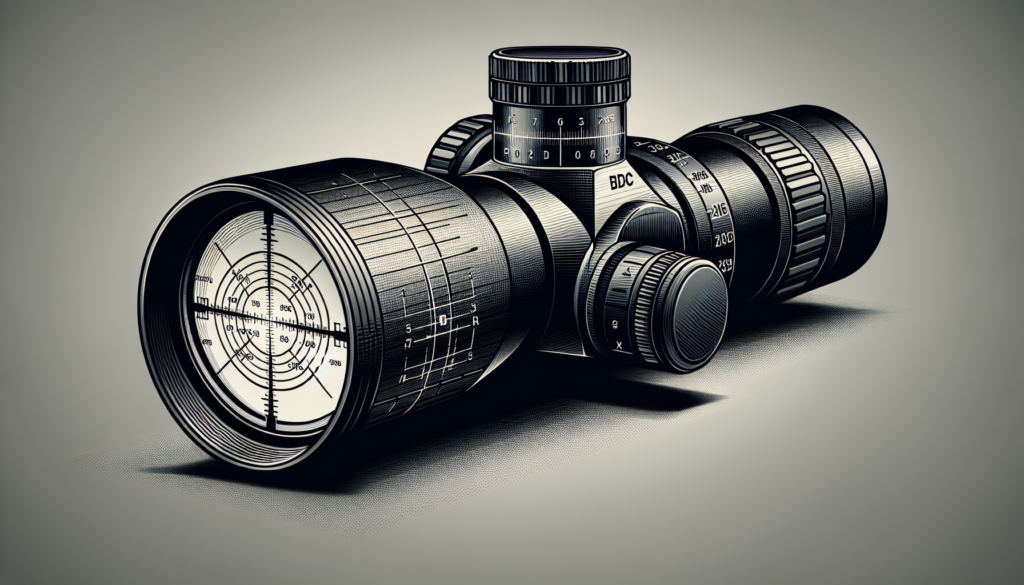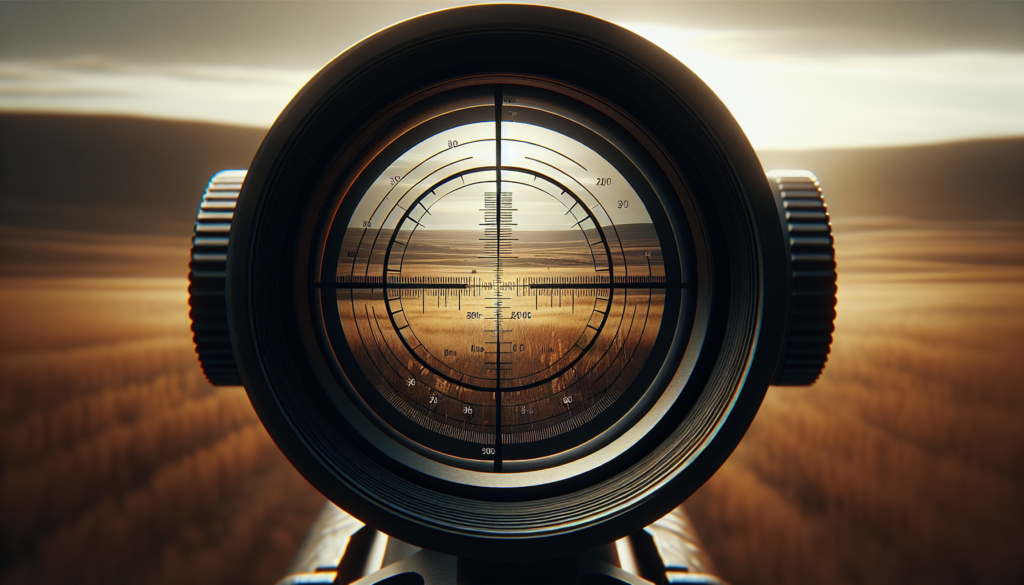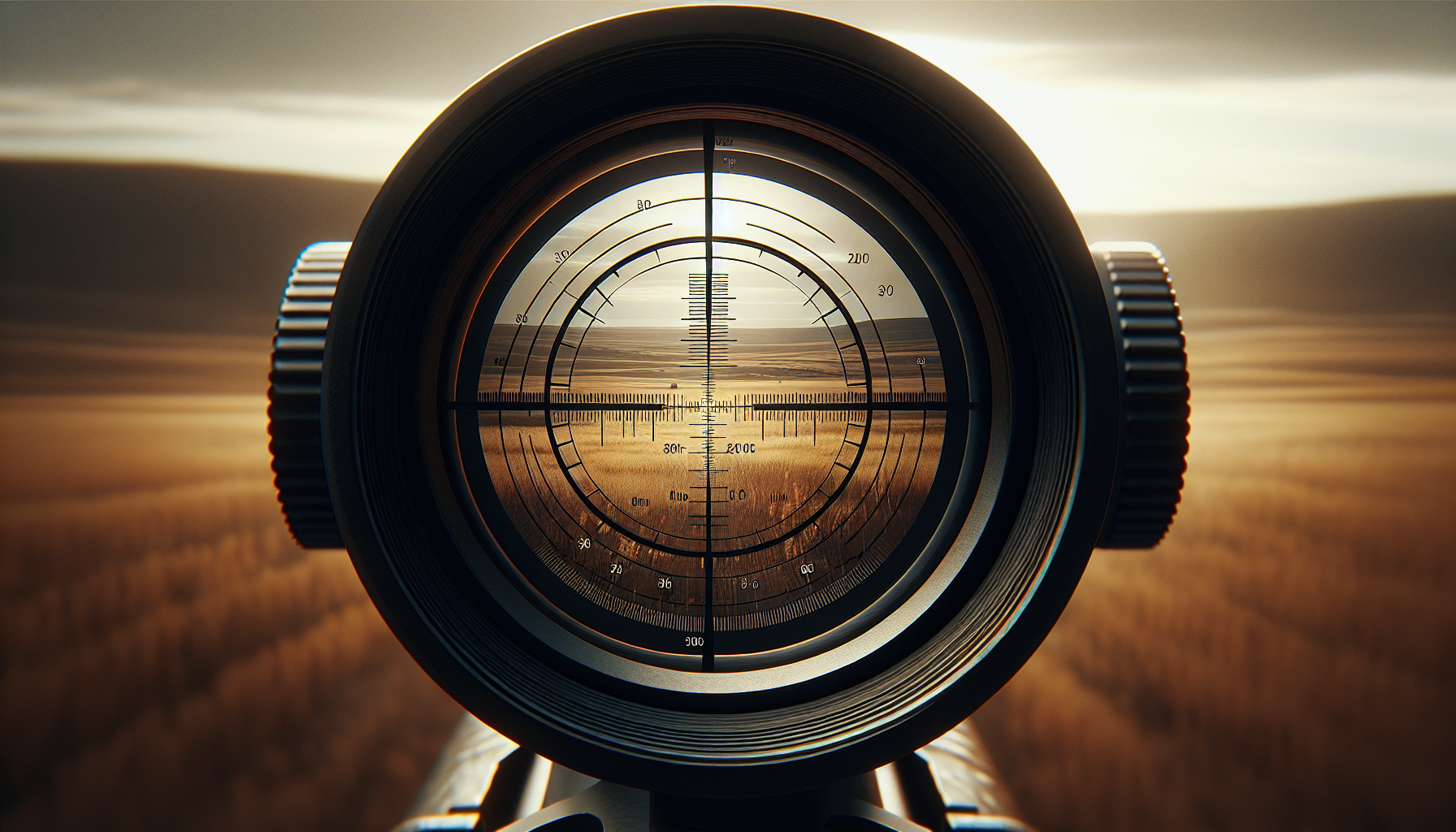Have you ever wondered what the purpose of a BDC reticle is? Well, look no further! This article will provide you with a clear understanding of the function of a BDC reticle. Whether you’re a seasoned hunter, competitive shooter, or simply curious about firearm optics, this informative piece will shed light on how this essential tool enhances accuracy and helps you hit your target with precision. Get ready to unravel the mysteries of the BDC reticle and unlock your shooting potential!
Understanding BDC Reticles
Definition of BDC Reticle
A BDC (Bullet Drop Compensating) reticle is a type of reticle in a rifle scope that is specifically designed to help shooters compensate for bullet drop at different distances. It features various markings or stadia lines that assist in estimating the distance to the target and making the necessary adjustments to ensure accurate shots.
Basic Structure and Design of a BDC Reticle
BDC reticles typically consist of multiple horizontal lines, also known as hash marks, below the center crosshair. These hash marks are placed at specific intervals and correspond to different distances. In addition to the horizontal lines, BDC reticles may also include additional elevation compensation marks, windage dots, or holdover lines, depending on the specific design. These elements work together to provide shooters with the necessary information to make precise long-distance shots.
The Purpose of a BDC Reticle
Facilitating Calculations for Bullet Drop
The primary purpose of a BDC reticle is to facilitate quick and accurate calculations for bullet drop at varying distances. By using the hash marks or other markings on the reticle, shooters can estimate the compensation needed to account for the drop in bullet trajectory as it travels further downrange. This eliminates the need for manual calculations or adjustments, allowing for faster target engagement.
Increasing Accuracy in Long Distance Shooting
Another crucial function of a BDC reticle is to enhance accuracy in long-distance shooting scenarios. By providing clear reference points for different distances, shooters can make precise holdover or elevation adjustments without needing to rely solely on trial and error or external devices such as rangefinders. The BDC reticle enables quicker target acquisition and more efficient shots, especially when engaging targets at extended ranges.

How Does a BDC Reticle Work?
Interpreting the Marks on the Reticle
To effectively use a BDC reticle, it is essential to understand how to interpret the markings on it. Each hash mark or additional element represents a specific distance, commonly measured in yards or meters. By aligning the appropriate mark with the target and adjusting the aim accordingly, the shooter compensates for the drop in bullet trajectory. This ensures the bullet hits the intended target at the desired distance.
Estimating Distance with a BDC Reticle
In addition to bullet drop compensation, BDC reticles can also aid in estimating target distance. By utilizing known reference points on the reticle, such as the size of the target or known object dimensions, shooters can make an educated estimation of the distance to the target. This estimation, combined with the corresponding hash mark for that distance, helps determine the necessary holdover or elevation adjustment to achieve accurate shots.
Adjusting for Windage and Elevation
While BDC reticles primarily assist with bullet drop compensation, some designs also incorporate additional elements for windage and elevation adjustments. These may include windage dots or holdover lines that can be used to compensate for the horizontal or vertical movement of the bullet caused by crosswinds or shooting at an elevated or downward angle. By utilizing the appropriate marks, shooters can make precise adjustments to counteract these external factors and maintain accuracy.
Types of BDC Reticles
BDC Reticles for Different Calibers
BDC reticles are designed to accommodate various bullet calibers and their corresponding ballistic characteristics. Different calibers have different bullet trajectories and drop rates, which necessitate specific reticle designs to provide accurate compensation. Manufacturers often offer BDC reticle models tailored for popular calibers like .223 Remington, .308 Winchester, or 6.5 Creedmoor, among others. It is crucial to choose a BDC reticle that matches the ballistics of the caliber being used to achieve optimal results.
BDC Reticles for Different Shooting Ranges
BDC reticles are also available in different variations optimized for specific shooting ranges. Some BDC reticles are designed for short-range shooting, typically within 100 to 300 yards, while others excel at medium to long-range engagements, reaching distances of 500 to 1000 yards or beyond. The reticle design and the spacing between the markings are specifically tailored to aid shooters in making accurate shots within their desired shooting range.
Comparative Analysis of Different BDC Reticle Types
With the wide availability of BDC reticles on the market, it can be beneficial to compare and analyze the different types to choose the most suitable one for a specific shooting application. Factors to consider include the design layout, the spacing and number of hash marks, the additional elements for windage and elevation adjustments, and the overall clarity and ease of use. By carefully evaluating these aspects, shooters can select a BDC reticle that aligns with their shooting requirements and preferences.

Calibration of BDC Reticles
The Importance of Correct Calibration
Ensuring the correct calibration of a BDC reticle is crucial for its effective use. Calibration refers to the alignment of the reticle’s markings with the specific ballistics of the ammunition being used. If the reticle is not calibrated correctly, shooters may experience significant inaccuracies in compensating for bullet drop or estimating target distance. Proper calibration ensures that the hash marks on the reticle correspond accurately with the actual bullet trajectory, resulting in precise adjustments and accurate shots.
Factors Affecting Calibration
Several factors can affect the calibration of a BDC reticle. These include the bullet weight, muzzle velocity, atmospheric conditions (such as altitude, temperature, and humidity), and any modifications made to the rifle or ammunition. Shooters must consider these factors and follow manufacturer guidelines or consult ballistics experts to calibrate the reticle properly. Failing to account for these factors may lead to inaccurate compensation and compromised shooting performance.
Steps for Calibrating a BDC Reticle
Calibrating a BDC reticle typically involves gathering specific ballistic data for the ammunition being used and adjusting the reticle accordingly. The process may include shooting at various distances, measuring the bullet impacts, and comparing them to the reticle’s markings. Manufacturers often provide detailed instructions or offer online tools and resources to guide shooters through the calibration process. It is essential to follow these instructions meticulously to achieve optimal calibration results.
Advantages of BDC Reticles
Ease of Use in Various Shooting Scenarios
One of the significant advantages of BDC reticles is their user-friendly nature. Shooters can quickly learn to interpret and utilize the reticle’s markings, making holdover or elevation adjustments intuitive and straightforward. BDC reticles eliminate the need for complex mathematical calculations or relying on external devices, allowing shooters to engage targets more efficiently and effectively in various shooting scenarios.
Enhanced Accuracy
BDC reticles significantly enhance accuracy in long-distance shooting. By providing clear reference points for bullet drop compensation, shooters can make precise adjustments without the need for trial and error or time-consuming calculations. This leads to more accurate shots, tighter groupings, and increased confidence for shooters engaging targets at extended ranges.
Quick Target Acquisition
BDC reticles facilitate quick target acquisition, particularly when engaging multiple targets at varying distances. Instead of taking time to adjust the scope or estimate bullet drop manually, shooters can simply align the appropriate hash mark on the reticle with the target and make the necessary holdover or elevation adjustment. This quick and seamless process allows for faster engagement of targets, especially in dynamic shooting scenarios.
Limitations of BDC Reticles
Potential Inaccuracy with Various Bullet Weights and Calibers
While BDC reticles are designed to provide accurate compensation for specific bullet calibers, weights, and ballistics, they may not be as effective with different ammunition combinations. Using bullets of varying weights or calibers that significantly deviate from the reticle’s calibration can lead to inaccuracies in bullet drop compensation. Shooters must ensure that the chosen BDC reticle is compatible with the specific ammunition they intend to use to maintain optimal accuracy.
Limited Usefulness at Extreme Distances
While BDC reticles excel in medium to long-range shooting, they may have limited usefulness at extreme distances. As the distance increases, factors such as wind, bullet velocity decay, and gravitational influences become more significant. BDC reticles may not provide enough precision or compensation for these complex factors at extreme distances. Shooters engaging targets at extreme ranges may need to rely on more advanced ballistic calculations or other shooting aids for accurate shots.
Choosing the Right BDC Reticle
Considerations when Buying a BDC Reticle
When choosing a BDC reticle, several considerations should be taken into account. These include the intended shooting application (hunting, sport shooting, tactical), the specific caliber and ammunition being used, the desired shooting range, and personal preferences regarding the reticle design and additional elements. It is essential to research and evaluate the available options, read reviews, and consult with experts or experienced shooters to select the most suitable BDC reticle for individual needs.
Popular BDC Reticle Brands and Models
Several reputable brands offer BDC reticles renowned for their quality and performance. Some popular brands include Leupold, Vortex Optics, Nikon, Trijicon, and Burris. Within these brands, specific BDC reticle models, such as the Leupold VX-3i, Vortex Optics Crossfire II, or Nikon P-Tactical, have gained recognition for their reliability and effectiveness. Exploring the offerings from these renowned brands can provide shooters with a wide selection of high-quality BDC reticles to choose from.
Tips for Using a BDC Reticle
Practicing with Different Ranges and Conditions
To fully utilize the capabilities of a BDC reticle, it is crucial to practice shooting at different ranges and under varied environmental conditions. This practice helps shooters become familiar with the reticle’s markings, build muscle memory for holdover or elevation adjustments, and understand how external factors such as wind or temperature affect bullet trajectory. Regular practice enables shooters to maximize the potential of their BDC reticle and improve their overall shooting skills.
Handling Parallax Issues
Parallax, the apparent movement of the reticle in relation to the target, can affect the accuracy of shots. To minimize the impact of parallax, shooters should understand how to properly adjust their scope’s parallax settings and maintain proper eye relief. Improperly addressed parallax issues can result in discrepancies between the reticle’s markings and the actual bullet impact, leading to inaccurate shots despite using a BDC reticle.
Maintaining Your BDC Reticle
Keeping your BDC reticle well-maintained is essential for its longevity and optimal performance. Regularly inspecting the reticle for any damage, such as scratches or smudges, is important to ensure clarity and readability. Cleaning the scope lenses and reticle using appropriate tools and materials removes any dirt or debris that may obstruct the clear view of the reticle. Proper storage and protection from extreme temperatures or impact can also contribute to the prolonged lifespan of the BDC reticle.
Case Studies of BDC Reticles in use
Sport Shooting Scenarios
BDC reticles are widely used by sport shooters, particularly in precision shooting competitions or long-range shooting events. Shooters benefit from the quick and accurate compensation for bullet drop, allowing them to engage targets swiftly and consistently. BDC reticles have been proven to enhance accuracy and improve overall performance in various sport shooting scenarios.
Hunting Scenarios
Hunters also find BDC reticles invaluable in their pursuits. Whether hunting medium-sized game or engaging targets at significant distances, BDC reticles aid in making accurate shots and increasing the chances of a successful harvest. The ease of use and quick target acquisition offered by BDC reticles are particularly advantageous in hunting scenarios, where time and precision are often critical.
Military and Law Enforcement Scenarios
In military and law enforcement scenarios, BDC reticles have proven to be reliable tools for engaging targets with accuracy and efficiency. The ability to quickly estimate target distance, compensate for bullet drop, and make on-the-fly adjustments plays a significant role in ensuring successful engagements. BDC reticles have become an integral part of the shooting systems utilized by armed forces and law enforcement agencies worldwide.
In conclusion, BDC reticles are valuable assets for shooters seeking enhanced accuracy and convenience in long-distance shooting. These reticles facilitate efficient bullet drop compensation, assist in estimating target distance, and provide quick target acquisition capabilities. However, shooters must consider various factors when choosing a BDC reticle, ensure correct calibration, and practice regularly to optimize their shooting performance. With their advantages in ease of use, increased accuracy, and quick target acquisition, BDC reticles have become essential tools for sport shooters, hunters, and professionals in military and law enforcement scenarios.

